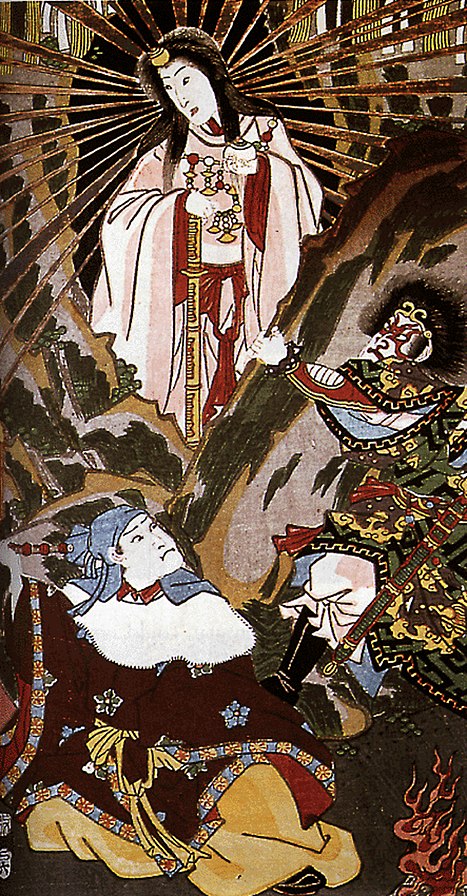
Amaterasu and the Imperial Regalia of Japan
 Japanese mythology embodies Shinto and Buddhist traditions and local folk religion. Japan has several gods or spirits known as “kami” in Japanese. Many Japanese myths are based on ancient texts such as the Kojiki and the Nihon Shoki. Japanese deities are mainly from Shinto (indigenous spirituality of Japan) and Buddhism beliefs that were integrated into Japanese folk tales. Amaterasu is the goddess of the sun in popular Shinto belief, and the Emperor of Japan is considered to be her direct descendant.
Japanese mythology embodies Shinto and Buddhist traditions and local folk religion. Japan has several gods or spirits known as “kami” in Japanese. Many Japanese myths are based on ancient texts such as the Kojiki and the Nihon Shoki. Japanese deities are mainly from Shinto (indigenous spirituality of Japan) and Buddhism beliefs that were integrated into Japanese folk tales. Amaterasu is the goddess of the sun in popular Shinto belief, and the Emperor of Japan is considered to be her direct descendant.
Amaterasu (天照), also known as Amaterasu-ōmikami or Ōhirume-no-muchi-no-kami, is a major Shinto deity. Her story can be traced all the way to the oldest known records of Japan’s history, in the Kojiki (680 AD) and the Nihon Shoki (720 AD). Amaterasu is the sister of Susanoo (the god of storms and sea) and Tsukuyom (god of the moon). The three siblings are believed to have painted the landscape that formed ancient Japan. Amaterasu, Susanoo, and Tsukuyomi are the children of Izanagi, a deity born of the seven divine generations. Izanagi, along with his sister and wife, Izanami (goddess of creation and death) gave birth to the many islands of Japan and numerous deities of Shintoism.
The three siblings were born when Izanagi was purifying himself after entering Yomi (the underworld). Tsukuyomi was was born when Izanagi washed his right eye, Susanoo was from the washing of the nose, and Ameterasu was from the washing of his left eye. Ameterasu shared ruling over the sun and the heavens with her brother and husband Tsukuyomi until he angered Ameterasu when he killed Uke Mochi (goddess of food). Thus, Ameterasu labeled Tsukuyomi an evil god and left him. This caused the separation between night from day.
Ancient texts also speak of Ameterasu and Susanoo’s bitter rivalry. Izanagi had ordered Susanoo to leave Heaven. Susanoo went to bid his sister goodbye but Ameterasu questioned his sincerity. This resulted in a challenge where each took an item from the other. Amaterasu chose a sword from Susanoo, while he chose Ameterasu’s necklace.
From the sword were born three women; from the necklace, five men. Ameterasu was declared the winner, and Susanoo wreaked havoc. Their conflict ended when Susanoo ceded Ameterasu his sword, the Kusanagi-no-Tsurugi (Grass Cutting Sword), in reconciliation.
According to legend, Amaterasu birthed descendants to whom she bequeathed some of her magical items. Among the descendants who received items from Ameterasu are Ninigi, who received the sacred mirror; Yata-no- Kagami, the jewel; and Kusanagi-noTsurugi, the sword of Susanoo. All three sacred items collectively became the Imperial Regalia of Japan.

